DODGE SPRINTER 2008 2.G Owners Manual
Manufacturer: DODGE, Model Year: 2008, Model line: SPRINTER, Model: DODGE SPRINTER 2008 2.GPages: 666, PDF Size: 14.11 MB
Page 181 of 666
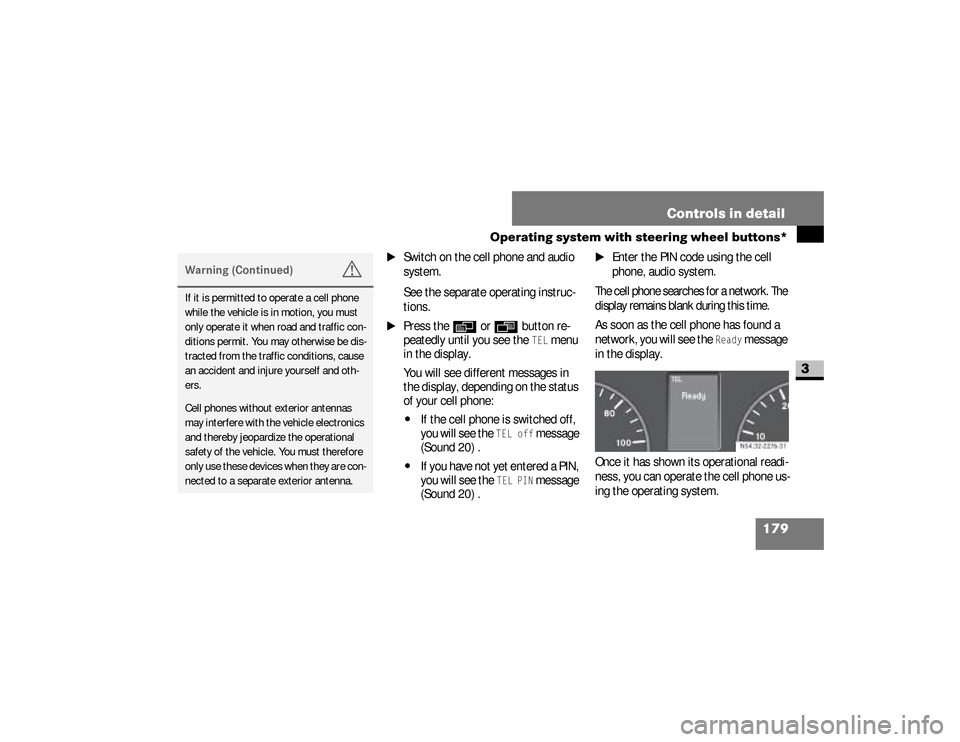
179 Controls in detail
Operating system with steering wheel buttons*
3
\1
Switch on the cell phone and audio
system.
See the separate operating instruc-
tions.
\1
Press the
è
or
ÿ
button re-
peatedly until you see the
TEL
menu
in the display.
You will see different messages in
the display, depending on the status
of your cell phone:
\4
If the cell phone is switched off,
you will see the
TEL off
message
(Sound 20) .
\4
If you have not yet entered a PIN,
you will see the
TEL PIN
message
(Sound 20) .
\1
Enter the PIN code using the cell
phone, audio system.
The cell phone searches for a network. The
display remains blank during this time.As soon as the cell phone has found a
network, you will see the
Ready
message
in the display.
Once it has shown its operational readi-
ness, you can operate the cell phone us-
ing the operating system.
Warning (Continued)
G
If it is permitted to operate a cell phone
while the vehicle is in motion, you must
only operate it when road and traffic con-
ditions permit. You may otherwise be dis-
tracted from the traffic conditions, cause
an accident and injure yourself and oth-
ers.Cell phones without exterior antennas
may interfere with the vehicle electronics
and thereby jeopardize the operational
safety of the vehicle. You must therefore
only use these devices when they are con-
nected to a separate exterior antenna.
N54.32-2276-31
nf_BA.book Page 179 Friday, January 25, 2008 3:53 PM
Page 182 of 666
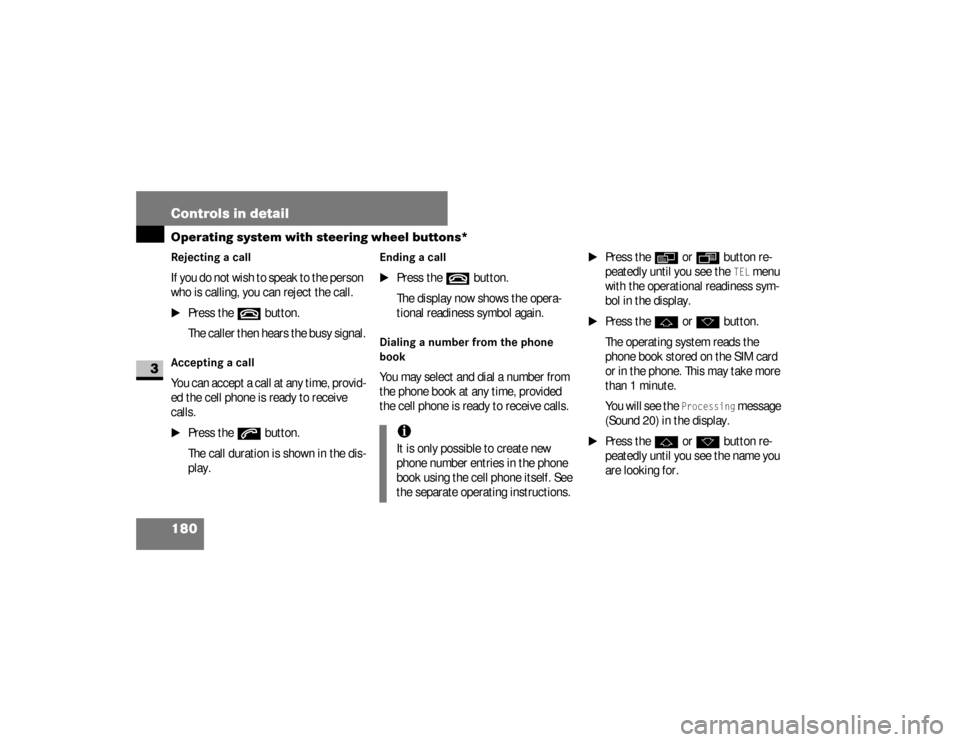
180 Controls in detailOperating system with steering wheel buttons*
3
Rejecting a callIf you do not wish to speak to the person
who is calling, you can reject the call.\1
Press the
t
button.
The caller then hears the busy signal.
Accepting a callYou can accept a call at any time, provid-
ed the cell phone is ready to receive
calls. \1
Press the
s
button.
The call duration is shown in the dis-
play.
Ending a call
\1
Press the
t
button.
The display now shows the opera-
tional readiness symbol again.
Dialing a number from the phone
bookYou may select and dial a number from
the phone book at any time, provided
the cell phone is ready to receive calls.
\1
Press the
è
or
ÿ
button re-
peatedly until you see the
TEL
menu
with the operational readiness sym-
bol in the display.
\1
Press the
j
or
k
button.
The operating system reads the
phone book stored on the SIM card
or in the phone. This may take more
than 1 minute.
You will see the
Processing
message
(Sound 20) in the display.
\1
Press the
j
or
k
button re-
peatedly until you see the name you
are looking for.
iIt is only possible to create new
phone number entries in the phone
book using the cell phone itself. See
the separate operating instructions.
nf_BA.book Page 180 Friday, January 25, 2008 3:53 PM
Page 183 of 666
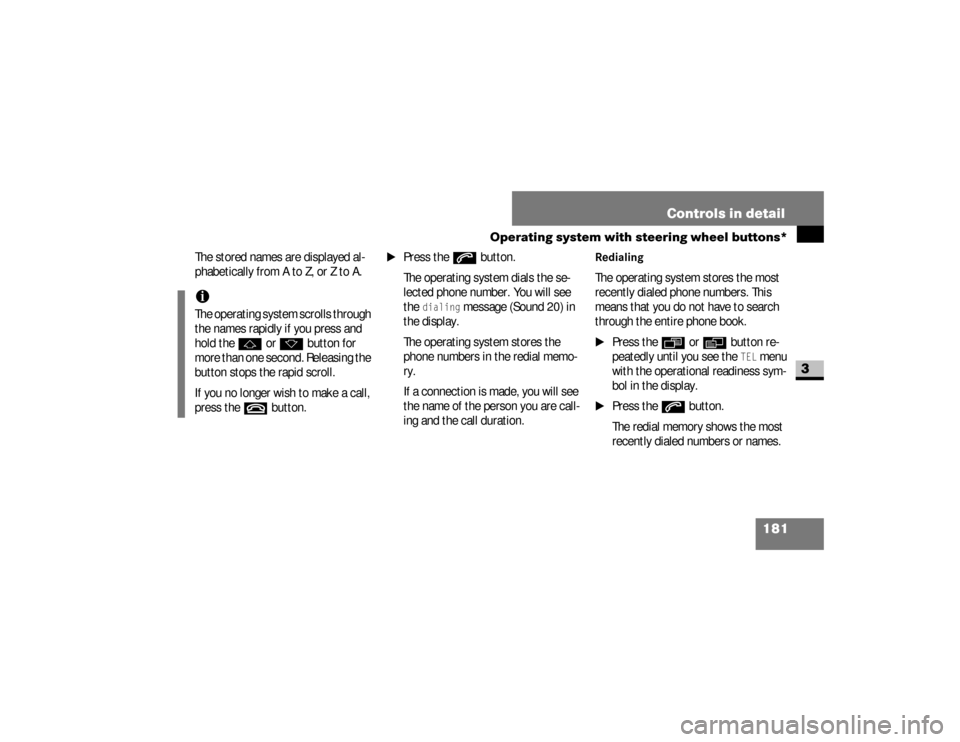
181 Controls in detail
Operating system with steering wheel buttons*
3
The stored names are displayed al-
phabetically from A to Z, or Z to A.
\1
Press the
s
button.
The operating system dials the se-
lected phone number. You will see
the
dialing
message (Sound 20) in
the display.
The operating system stores the
phone numbers in the redial memo-
ry.
If a connection is made, you will see
the name of the person you are call-
ing and the call duration.
RedialingThe operating system stores the most
recently dialed phone numbers. This
means that you do not have to search
through the entire phone book.\1
Press the
ÿ
or
è
button re-
peatedly until you see the
TEL
menu
with the operational readiness sym-
bol in the display.
\1
Press the
s
button.
The redial memory shows the most
recently dialed numbers or names.
iThe operating system scrolls through
the names rapidly if you press and
hold the
j
or
k
button for
more than one second. Releasing the
button stops the rapid scroll.
If you no longer wish to make a call,
press the
t
button.
nf_BA.book Page 181 Friday, January 25, 2008 3:53 PM
Page 184 of 666

182 Controls in detailOperating system with steering wheel buttons*
3
\1
Press the
j
or
k
button re-
peatedly until the number or the
name you are looking for is dis-
played.
\1
Press the
s
button.
The operating system dials the se-
lected phone number.
If a connection is made, you will see
the call duration and name of the
person you are calling if stored in the
phone book. Otherwise, the number
you are dialing continues to be dis-
played.
iIf you no longer wish to make a call,
press the
t
button.
nf_BA.book Page 182 Friday, January 25, 2008 3:53 PM
Page 185 of 666
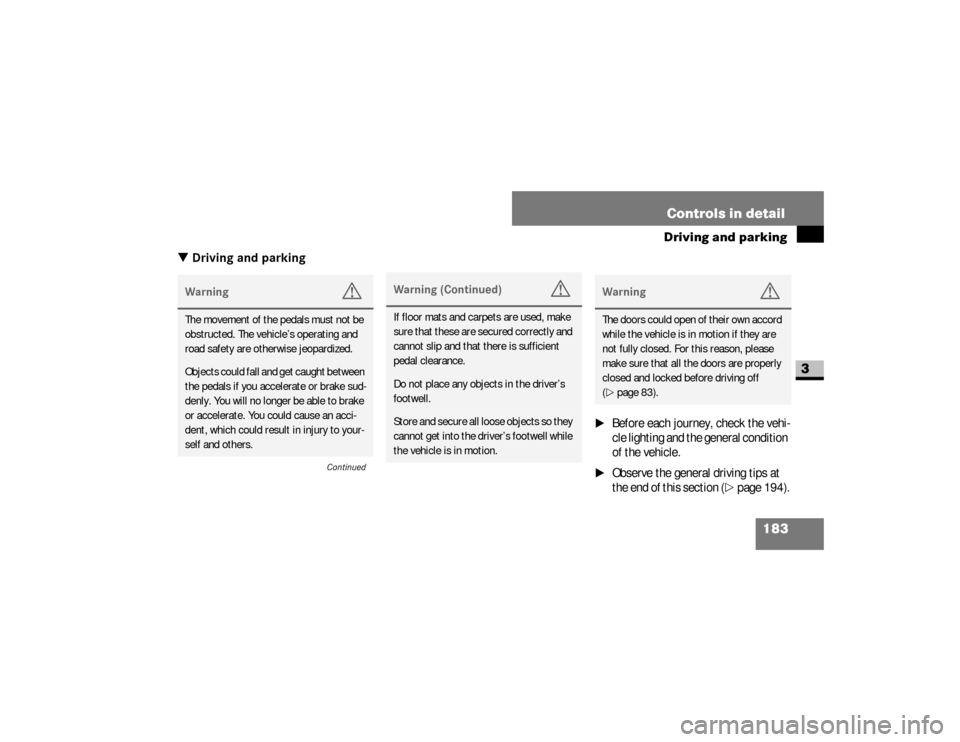
183 Controls in detail
Driving and parking
3
\3 Driving and parking
\1
Before each journey, check the vehi-
cle lighting and the general condition
of the vehicle.
\1
Observe the general driving tips at
the end of this section (
\2
page 194).
Warning
G
The movement of the pedals must not be
obstructed. The vehicle’s operating and
road safety are otherwise jeopardized.Objects could fall and get caught between
the pedals if you accelerate or brake sud-
denly. You will no longer be able to brake
or accelerate. You could cause an acci-
dent, which could result in injury to your-
self and others.
Continued
Warning (Continued)
G
If floor mats and carpets are used, make
sure that these are secured correctly and
cannot slip and that there is sufficient
pedal clearance.Do not place any objects in the driver’s
footwell.Store and secure all loose objects so they
cannot get into the driver’s footwell while
the vehicle is in motion.
Warning
G
The doors could open of their own accord
while the vehicle is in motion if they are
not fully closed. For this reason, please
make sure that all the doors are properly
closed and locked before driving off
(\2page 83).
nf_BA.book Page 183 Friday, January 25, 2008 3:53 PM
Page 186 of 666
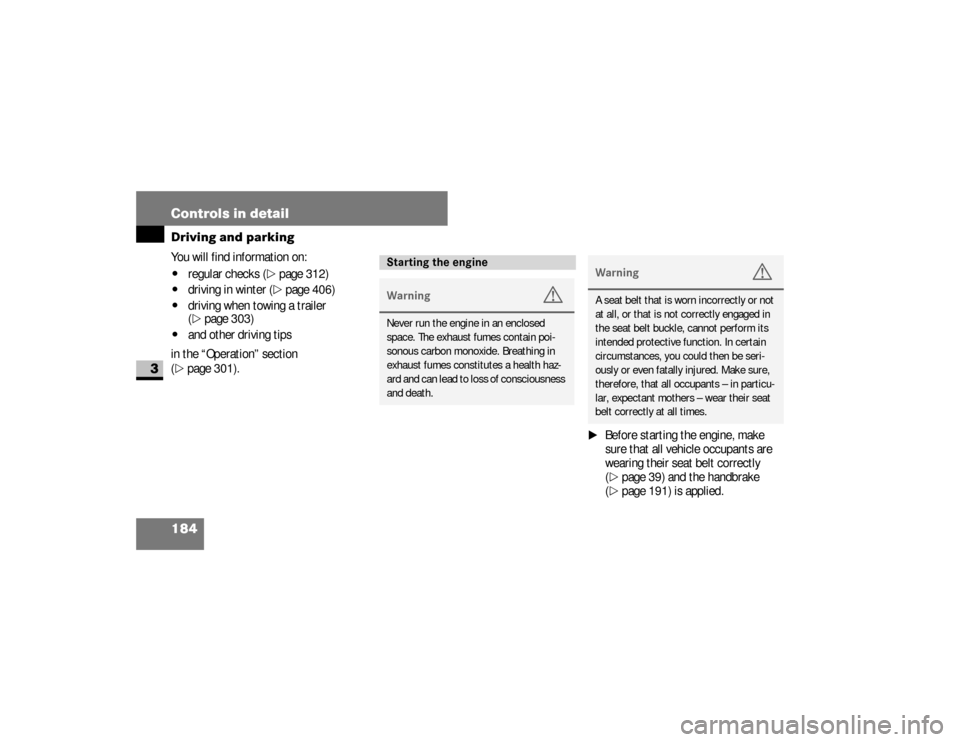
184 Controls in detailDriving and parking
3
You will find information on:\4
regular checks (
\2
page 312)
\4
driving in winter (
\2
page 406)
\4
driving when towing a trailer
(\2
page 303)
\4
and other driving tips
in the “Operation” section
(
\2
page 301).
\1
Before starting the engine, make
sure that all vehicle occupants are
wearing their seat belt correctly
(\2
page 39) and the handbrake
(
\2
page 191) is applied.
Starting the engineWarning
G
Never run the engine in an enclosed
space. The exhaust fumes contain poi-
sonous carbon monoxide. Breathing in
exhaust fumes constitutes a health haz-
ard and can lead to loss of consciousness
and death.
Warning
G
A seat belt that is worn incorrectly or not
at all, or that is not correctly engaged in
the seat belt buckle, cannot perform its
intended protective function. In certain
circumstances, you could then be seri-
ously or even fatally injured. Make sure,
therefore, that all occupants – in particu-
lar, expectant mothers – wear their seat
belt correctly at all times.
nf_BA.book Page 184 Friday, January 25, 2008 3:53 PM
Page 187 of 666
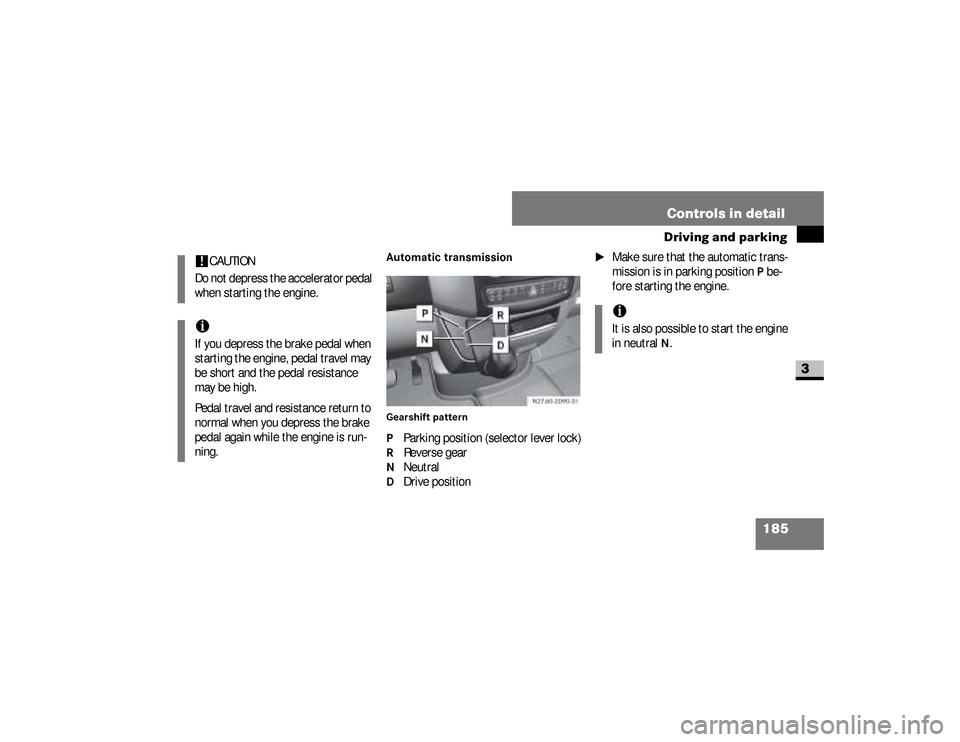
185 Controls in detail
Driving and parking
3
Automatic transmissionGearshift patternP Parking position (selector lever lock)R Reverse gearN NeutralD Drive position
\1
Make sure that the automatic trans-
mission is in parking position
P be-
fore starting the engine.
!
CAUTION
Do not depress the accelerator pedal
when starting the engine.
iIf you depress the brake pedal when
starting the engine, pedal travel may
be short and the pedal resistance
may be high.
Pedal travel and resistance return to
normal when you depress the brake
pedal again while the engine is run-
ning.
iIt is also possible to start the engine
in neutral
N.
nf_BA.book Page 185 Friday, January 25, 2008 3:53 PM
Page 188 of 666
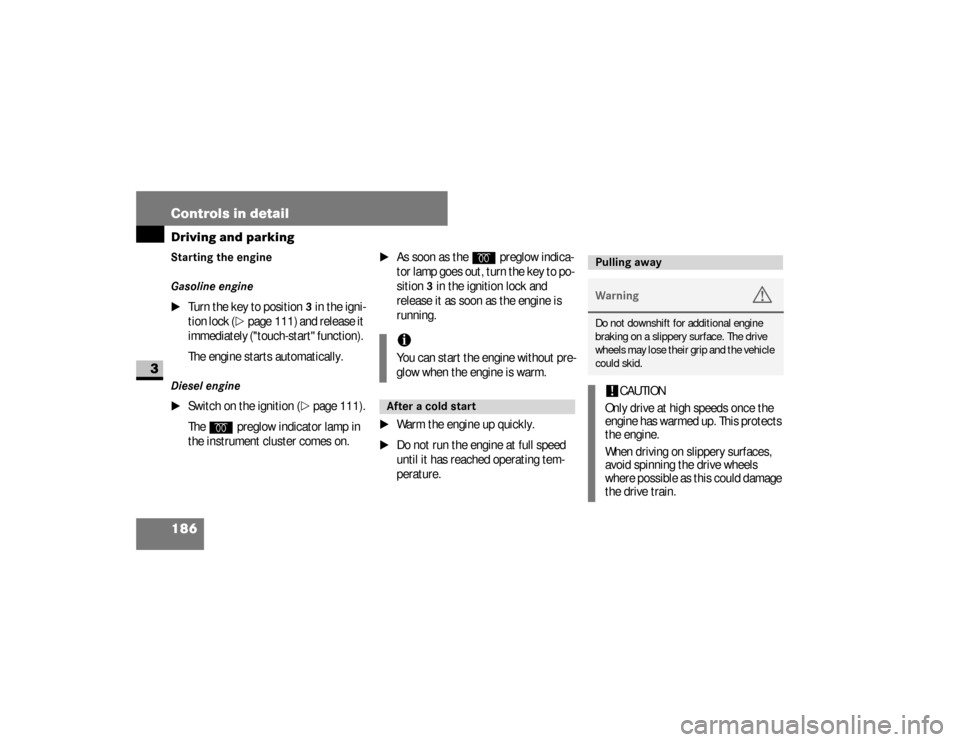
186 Controls in detailDriving and parking
3
Starting the engine
Gasoline engine
\1
Turn the key to position
3 in the igni-
tion lock (
\2
page 111) and release it
immediately ("touch-start" function).
The engine starts automatically.
Diesel engine
\1
Switch on the ignition (
\2
page 111).
The
q
preglow indicator lamp in
the instrument cluster comes on.
\1
As soon as the
q
preglow indica-
tor lamp goes out, turn the key to po-
sition
3 in the ignition lock and
release it as soon as the engine is
running.
\1
Warm the engine up quickly.
\1
Do not run the engine at full speed
until it has reached operating tem-
perature.iYou can start the engine without pre-
glow when the engine is warm.After a cold start
Pulling awayWarning
G
Do not downshift for additional engine
braking on a slippery surface. The drive
wheels may lose their grip and the vehicle
could skid.!
CAUTION
Only drive at high speeds once the
engine has warmed up. This protects
the engine.
When driving on slippery surfaces,
avoid spinning the drive wheels
where possible as this could damage
the drive train.
nf_BA.book Page 186 Friday, January 25, 2008 3:53 PM
Page 189 of 666
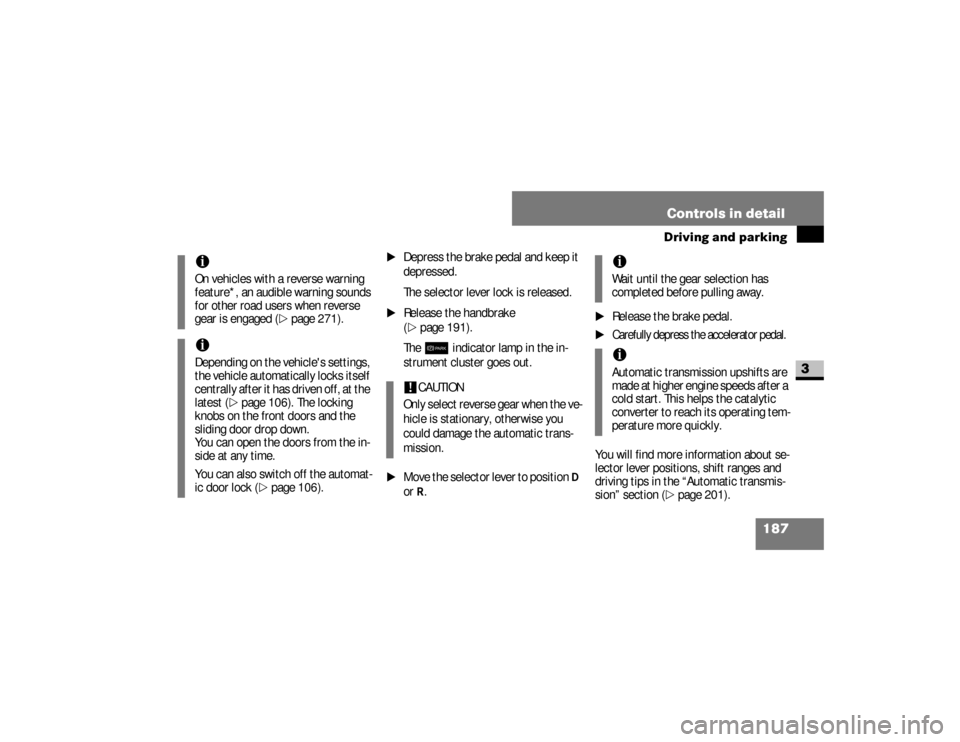
187 Controls in detail
Driving and parking
3
\1
Depress the brake pedal and keep it
depressed.
The selector lever lock is released.
\1
Release the handbrake
(\2
page 191).
The7
indicator lamp in the in-
strument cluster goes out.
\1
Move the selector lever to position
D
or
R.
\1
Release the brake pedal.
\1
Carefully depress the accelerator pedal.
You will find more information about se-
lector lever positions, shift ranges and
driving tips in the “Automatic transmis-
sion” section (
\2
page 201).
iOn vehicles with a reverse warning
feature*, an audible warning sounds
for other road users when reverse
gear is engaged (
\2
page 271).
iDepending on the vehicle's settings,
the vehicle automatically locks itself
centrally after it has driven off, at the
latest (
\2
page 106). The locking
knobs on the front doors and the
sliding door drop down.
You can open the doors from the in-
side at any time.
You can also switch off the automat-
ic door lock (
\2
page 106).
!
CAUTION
Only select reverse gear when the ve-
hicle is stationary, otherwise you
could damage the automatic trans-
mission.
iWait until the gear selection has
completed before pulling away.iAutomatic transmission upshifts are
made at higher engine speeds after a
cold start. This helps the catalytic
converter to reach its operating tem-
perature more quickly.
nf_BA.book Page 187 Friday, January 25, 2008 3:53 PM
Page 190 of 666
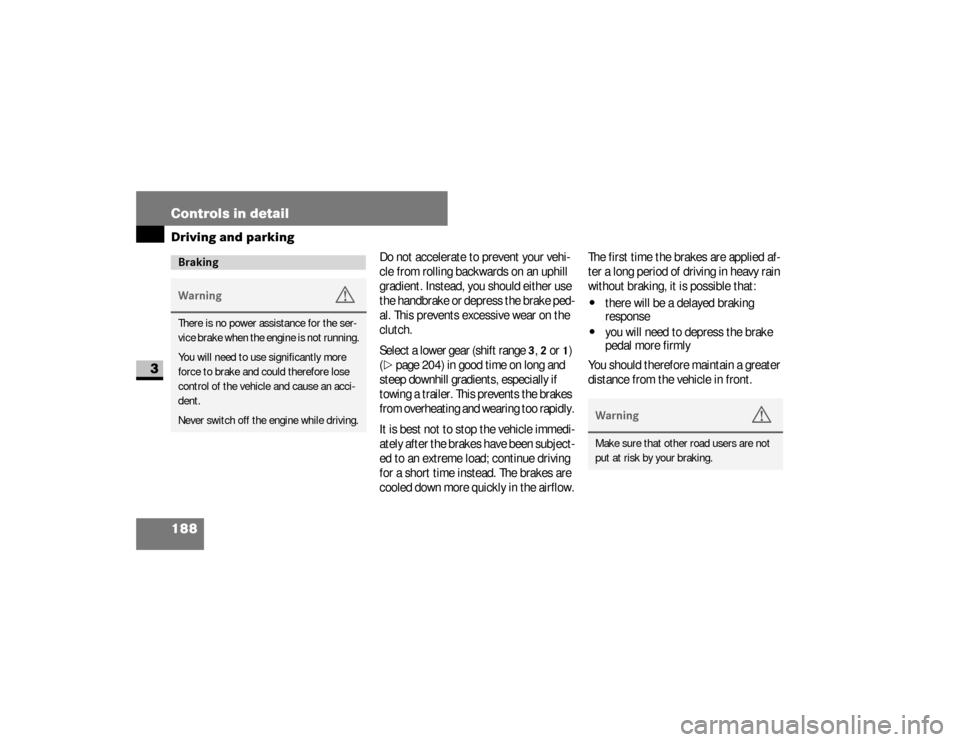
188 Controls in detailDriving and parking
3
Do not accelerate to prevent your vehi-
cle from rolling backwards on an uphill
gradient. Instead, you should either use
the handbrake or depress the brake ped-
al. This prevents excessive wear on the
clutch.
Select a lower gear (shift range
3, 2 or
1)
(
\2
page 204) in good time on long and
steep downhill gradients, especially if
towing a trailer. This prevents the brakes
from overheating and wearing too rapidly.
It is best not to stop the vehicle immedi-
ately after the brakes have been subject-
ed to an extreme load; continue driving
for a short time instead. The brakes are
cooled down more quickly in the airflow.The first time the brakes are applied af-
ter a long period of driving in heavy rain
without braking, it is possible that:
\4
there will be a delayed braking
response
\4
you will need to depress the brake
pedal more firmly
You should therefore maintain a greater
distance from the vehicle in front.
BrakingWarning
G
There is no power assistance for the ser-
vice brake when the engine is not running.
You will need to use significantly more
force to brake and could therefore lose
control of the vehicle and cause an acci-
dent.
Never switch off the engine while driving.
Warning
G
Make sure that other road users are not
put at risk by your braking.
nf_BA.book Page 188 Friday, January 25, 2008 3:53 PM